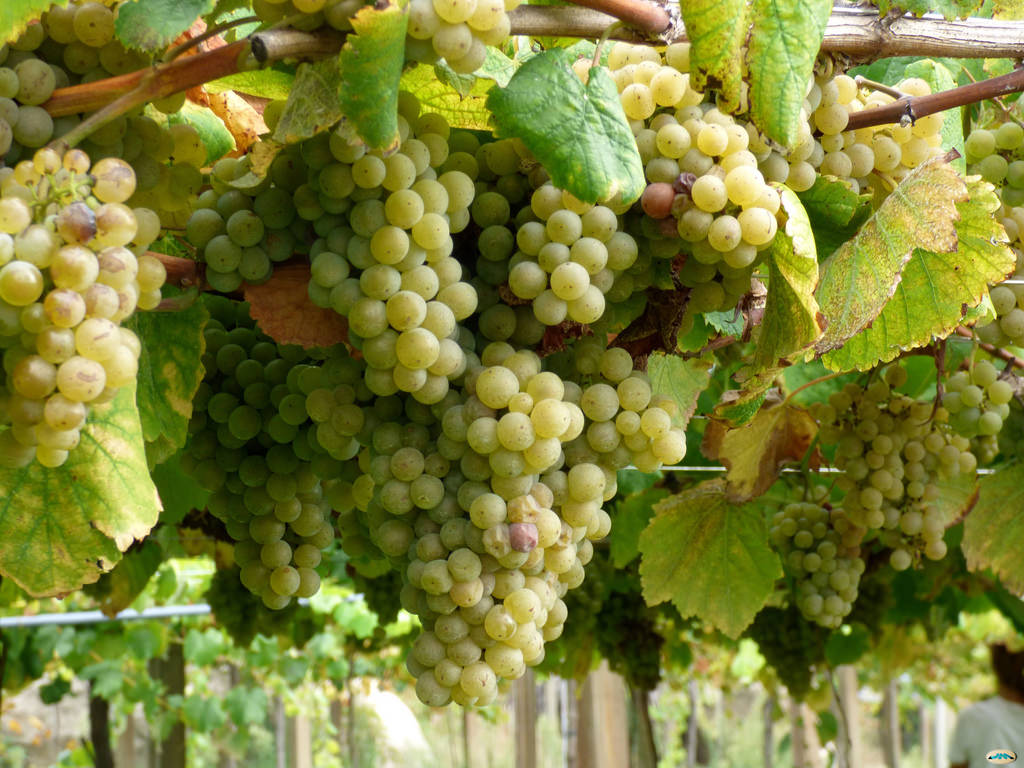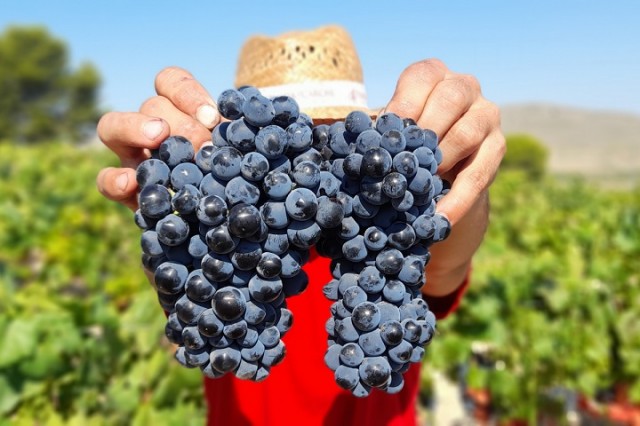The process of converting grapes into wine is divided into three general stages: pre-fermentation, fermentation and post-fermentation. More specifically, we can refer to the mechanical operations for processing the grapes, correction of the must, vatting, separation of the wine, and lastly, the final fermentation. Historically, vinification has been a heterogeneous process that varied according to the areas in which it was performed or the type of wine to be made. Currently, this process is becoming standardised for white, rosé, claret and red wines, and is moving towards a much more homogeneous vinification.

WHITE WINE
To transform grapes into white wine, the first step in the vinification process is pressing, in which the must is extracted by exerting pressure on the grapes.
Once the must is obtained, the next operation is called clarification and involves cleaning the must so it is fresher and lighter. This step must be carried out before fermentation begins.
If necessary, the vintage is corrected to modify the colour of the must, by means of intense aeration and the use of charcoal to discolour it.
The must is then placed in tanks or wooden casks in a process known as vatting. Next is fermentation, carried out at low temperatures so as to convert the sugars into alcohol. If a dry white wine is desired, fermentation is carried out spontaneously; in other instances, it is necessary to interrupt fermentation by various methods such as heating or chilling. The last two stages are de-vatting, which separates the wine from other solid materials just after fermentation is completed, and finally racking, transferring the wine from one tank to another by decanting it.
ROSÉ WINE
The vinification process for rosé wines is very similar to that for white wines. Both white and red grapes are used to make rosé, but it is the red grapes that are indispensable for the colouration of the wine. The first step consists of placing the grapes in a vat. The volume of the grapes crushes the harvest to release the coloured must, which ferments after a few hours. From then on, the same processes are followed as for white wine.

RED WINE
Red grapes are predominantly used in red wines because their skin is necessary for the wine colouration process to have the proper results. This vinification process can be done in two ways. The most typical is the industrial or winery method, and the other is the classic method, also known as carbonic maceration.
In the industrial method, the bunches of grapes are transferred to tanks and from there pass to a crusher/de-stemmer to press the grapes. The fruits and the must, while still mixed together, are then transferred through a pipe to large fermentation tanks.
When this fermentation is completed, the "free-run wine" is extracted through the lower part of the tank and is racked to different tanks where it will have to be decanted to eliminate sediments.
Finally, the second fermentation, called malolactic fermentation, proceeds with the help of heat to block lactic bacteria. These bacteria trigger the fermentation of malic acid, which is transformed into lactic and carbonic acid. Lactic acid is an important factor in the finish of red wines.
If the wine is for immediate consumption, the processes followed are very similar to those followed for rosés and white wines: racking, clarification, filtering, etc.
SPARKLING WINE
Sparkling wines all have a high carbon-dioxide content, which is obtained naturally by means of a second fermentation. It can also be obtained artificially, but this is done in a minority of cases.
Cava is the name by which the most exalted sparkling wines are known in Spain. This type of wine has been made for more than one hundred years, predominantly in the Penedés region, and its difference with respect to French champagne is the type of grape permitted by the respective regulating boards.
A good wine with an acidity of between 7 and 8 grams is indispensable for making a good Cava. It is bottled in traditional dark green bottles to protect it from sunlight, and the bottles are made of very thick glass to withstand the pressure that develops inside them. Sugar and yeast are added to the wine to produce the second fermentation.
Once the bottles are closed, they are stacked on their sides and allowed to rest for a minimum of nine months in order to earn the right to the name of Cava. Cava Gran Reserva, for example, must rest for thirty months to earn this classification.
While the wine is resting or en rima, as it is known in the wine-grower's slang, the second fermentation occurs in the bottle. In this process, the sediment, or lees, will accumulate on one side of the bottle. The next step is to transfer the bottles to tilted wine racks with the goal of collecting the sediment at the edge of the stopper.
The vintner then proceeds to disgorge the wine, freezing the neck of the bottle where the sediment is. When the stopper is removed, the carbon dioxide gas in the Cava causes the frozen plug to fly out, taking the impurities with it.
In this step, the bottle loses liquid, which is re-added with the dosage or Licor de expedición, simply a mixture of brandy, wine and sugar in the proportions each Cava maker thinks best. The flavour of each Cava is defined by this mixture. Finally, the bottles pass through the corking machine to be stopped with a cork, which is marked on the inside with a four-pointed star as a sign of distinction. The wire, also known as morrión, holds the cork in place.
WHITE GRAPE VARIETIES POPULAR IN SPAIN
ALBARIÑO: Produced under the Rías Baixas Designation of Origin with small, sweet berries, producing high-quality white wines. This type of grape is native to Galicia. In recent years it has become much more widely used, having been also introduced to the north of Portugal.
ALBILLO: A variety of white grape that has a slightly sweet taste due to its high glycerol content The berries are golden yellow, and have a very characteristic aroma. . It is also known under the name of Castellano, Pardillo and Uva Perruna, among others.
AIRÉN: Originally from La Mancha. It is the most widely planted variety in Spain. It occupies 30% of the vine-planted surface in the world, making it the most cultivated variety.
CHARDONNAY: Considered to be the queen of white grapes. The most highly prized examples are found in the region of Burgundy. No Chardonnay is the same as any other, as they differ according to the area of cultivation. It is an aristocratic grape, very delicate with attractive aromas. It offers excellent results with only a little ageing in casks. It is used in the production of champagnes and Cavas.
GODELLO: Native to Galicia and listed under the Valdeorras Designation of Origin, as well as being one of the main varieties for Bierzo. It is characterised by its great quality and its aromatic strength.
MACABEO: Also known as Viura, this variety is present in many wines from Catalonia, La Rioja, Aragon and Badajoz.
MALVASIA: Originally from Asia Minor, it has a long tradition in Spain. This type of grape produces a lot of must, which is bittersweet, but at the same time pleasant. In Catalonia, it is called Subirat Parent and has the Calatayud Designation of Origin.
MOSCATEL: A sweet grape, with smooth, round berries, that can be white or purple. It has the Malaga and Valencia Designations of Origin, and may originally come from Alexandria. It is a very common dessert grape, and is abundant in Spain.
PEDRO XIMENEZ: Much used in Spain in the production of table wine. It is a variety of the muscatel grape. The grape is round, with fine, delicate skin and it is sensitive to humid climates. It needs special production conditions and the resulting wines are of high quality.
SAUVIGNON: This grape is considered to be one of the most select varieties among white grapes. Originally from France, and mainly cultivated in Castile and Leon and Catalonia. With an aromatic sensuality and exceptional palate, it produces elegant, dry, acidic wines.
RED GRAPE VARIETIES POPULAR IN SPAIN
BOBAL: A variety of red grape, with red, juicy berries rich in colourants. The wine it produces is of an intense cherry colour with low alcohol content.
CABERNET FRANC: It produces wines of a notable smoothness. Much used in France, in Spain it is found above all in Galicia and Castile, and its use is limited.
CABERNET SAUVIGNON: This is the most international grape due to its adaptation to all kinds of climate. The wines it produces are elegant, austere and sensual. Very common in Catalonia, Navarre and the Ribera del Duero.
CARIÑENA: This grape predominates in Catalan red wines as well as those from La Rioja, although France is where it is found in abundance. The must this type of grape produces is of abundant colour and acidity, hard, and with little aroma.
GARNACHA TINTA: A Mediterranean variety with sweet, oval, berries that are purple in colour. Rustic and resistant to drought, plagues and diseases, it is the most widely cultivated Mediterranean grape in the world. It tends to be overly criticised by those who are unaware of its potential.
GARNACHA TINTORERA: One of the principal characteristics of this type of grape is its coloured pulp. The wines it produces are attractive. It has the Almansa Designation of Origin, and it has reached other regions such as Albacete, Alicante and Galicia.
JUAN GARCIA: A type of Spanish grape, specifically from Los Arribes del Duero and very difficult to find in other areas. It is also known by the name Malvasía Negra. It provides wines with low alcohol content.
MALBEC: Native to Bordeaux. It produces wine with complex aromas and is long-lasting on the palate. It was introduced to the Ribera del Duero, among other areas in the peninsula, many years ago.
MENCIA: One of the first varieties to be introduced in the peninsula, it has thick skin, a colourless juice and a neutral taste. It produces fruity wines and is widespread in Leon, Zamora, Lugo and Orense. Bierzo and Valdeorras Designations of Origin.
MERLOT: Native to Bordeaux. With an enviable smoothness and lightness. Present in Catalonia,
Navarre, Ribera del Duero, Ribera del Guadiana and Somontano.
MONASTRELL: A variety that is widespread everywhere, and the second most important red grape in Spain. It has a small, round berry which is sweet and very productive.
MORISTEL: Abundant in Huesca and Zaragoza. It is one of the principal varieties used in the Somontano Designation of Origin.
PRIETO PICUDO: It comes from Leon and Zamora. Wines from the Bierzo Designation of Origin are produced with this grape. They are very aromatic and light in colour.
TEMPRANILLO: Native to La Rioja. It is susceptible to blights and diseases, but in spite of that, it is considered to be the best Spanish red variety. The must this grape produces is balanced in sugar, colour and acidity, and it is also very aromatic.